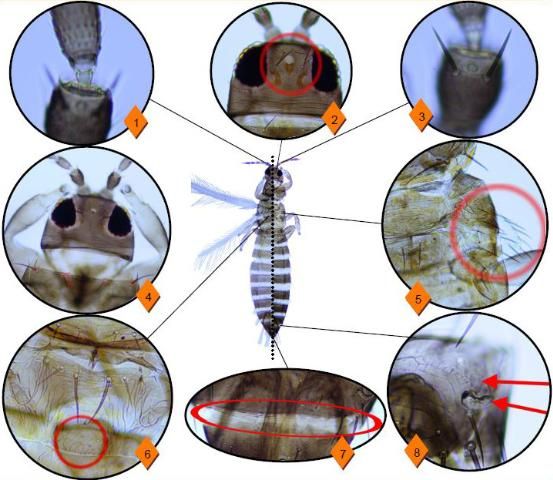Morphology

Credit: Jeffrey Cluever
- Smooth pedicel at base of antennal segment III.
- Ocellar III setae not arising between posterior ocelli.
- Setae arising from antennal segment II not formingstout spines.
- 4 major setae on pronotum; center pair short.
- Wings not well-developed in some forms.
- Metanotal campaniform sensilla present.
- Comb on tergite VIII absent.
- Ctenidium (upper arrow) on tergite VIII anterior tospiracle (lower arrow).
Appearance
Egg
Eggs are small, embedded in the foliage, and unlikely to be seen.
Larvae
Light in color, wingless, and usually not differentiated from other larvae.
Pupal Stages
Wing buds present with antennae pointed straight out (prepupa) or with antennae pulled back over the head (pupa). Pupal stages are not usually identified.
Adult
Two wing morphs exist, a macropterous morph with normal wings and a brachypterous morph, which lacks well-developed wings. Similar to other Frankliniella spp., the adult has 4 major setae on the anterior margin of the pronotum. Also similar to other Frankliniella spp., it has ctenidia (oblique rows of fine hairs [often appearing as dots]) on tergite VIII that are anterior to the spiracles.
Other Diagnostic Features
The pedicel (base of antennal seg-ment III) is smooth. Ocellar III setae (large pair nearest the ocelli) do not arise between posterior ocelli. The inner 2 major setae on the anterior margin of the pronotum are short. Metanotal campaniform sensilla (sensory structures that appear as two small dots) are present. The comb on tergite VIII (row of microtrichia) is absent.
Life Cycle
F. fusca exhibits all the life stages common to terebrantian thrips: the egg, larva I, larva II, prepupa, pupa, and theadult stage. The length of each life stage varies according to temperature and host plant. The South Carolina seasonalaverage is as follows:
- The female lays an egg into the foliage; 6.7 days later it hatches.
- The larva I and II stages feed on their host for 2.3 and 3.5 days respectively.
- At the end of larva II stage the thrips may drop to the soil to pupate. The non-feeding prepupal and pupal stageslast 1.1 and 2.6 days respectively before the adult emerges.
Host Range and Distribution
Hosts
Many hosts, including corn, cotton, peanut, pepper, soybean, tobacco, tomato, and various wild plant species.
Origin
Southeastern United States.
Global Distribution
Caribbean, Europe, and North America.
Types of Injury
This species transmits Tomato spotted wilt virus and Impatiens necrotic spot virus.
It is a flower and foliage feeder. Feeding on the foliage may cause silvering followed by necrosis. Young seedlings may be killed by feeding. Feeding in the bloom may cause petal browning or malformed fruit. Feeding on the fruit may cause bronzing or scarring. Oviposition blisters may occasionally be seen.